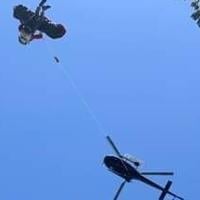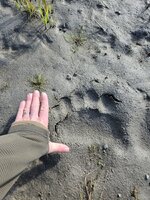Don’t be this guy….
A final report from the Wyoming Game and Fish Department (WGFD)- concludes the investigation into the tragic death of Mark Uptain, the hunting guide who was killed by a sow grizzly bear in the Bridger-Teton National Forest on September 14,... [Read More]

huntershield.com
That’s a great article - should be required reading.
Pepper spray, pistol, or rifle have to be easily reachable to work, and muscle memory has to make it automatic.
Bears have personalities just like all animals, including us, and there is a wide variation in aggressiveness and thought processes.
It can be helpful to think in terms of rattle snakes - a few changes in your behavior greatly reduce the odds of getting bit. In snake country when climbing up a steep hill you don’t put your hand any place you can’t see. In sagebrush you don’t walk directly next to, or step over, anything you can’t see under or through. In ten seasons of wildland firefighting I’ve only been present with one snake bite, and that was a young rattle snake that climbed up into some brush and barely got one fang into the guy’s arm as the 6 of us were bushwhacking down a hill. We never saw the snake, and none of us had ever seen a snake hanging out that high in brush.
In griz country much of it is pretty open, or at least open enough you can pick a route with enough visibility to see a bear 50 yards out. Yes you will do more walking, and it might give you away to more game. Your personal danger threshold does change how you hunt - I’m not an extreme skier and you won’t find me still hunting dense clumpy timber in bear country, heck I won’t backpack in the primary grizzly habitat. One common thread to a lot of bear attacks is they walk around a bushy tree or rock and there is momma with a cub. Giving wide berth to dense brush or thick clumps of trees is as important as not stepping directly next to thick sage or putting a hand onto an unknown rock ledge blindly in snakey areas.
The only way to eliminate your chances of a run in is to stay home, but odds are based on your behavior so make good choices. There is a lot of stupid to be found walking on two legs, if they grew up in bear country or not. It‘s amazing more people aren’t killed given the poor choices made, so don’t blindly see a behavior and assume it’s ok to duplicate.
If you are fascinated with bears it’s fun to hang out in the NE side of Yellowstone just watching the daily movement of bears on a kill or not. The wolves drive them off, but bears are often the first ones there in the morning. If wolves don’t know about the kill a bear beds much closer to guard it. Looking at the kill and what’s around it - it would be amazingly easy to stumble into it if you just happened to be crossing through and were at the wrong place at wrong time. As with most animals a bedded grizzly can be almost impossible to see depending on the angle.
A buddy system is safer. More open country is safer. Being alert is safer. Rifle in hand with scope covers off and round in chamber when going through a thick patch you can’t go around is safer.
Problem bears are well known to FS Rangers, F&G Game wardens and biologists prior to the hunting season - I make it a point to find out if there have been black or griz issues on any backcountry trip. Problem bears are sometimes relocated to certain drainages. A helicopter pilot once told me of a couple problem bears he flew into the backcountry.
Keep in mind you may be 100 miles from what’s considered grizzly range, but individual bears can travel great distances outside their normal range for relatively short durations. I’ve seen as many grizzly above timberline as below it.
Every bear learns as a cub that gut piles are full of the good stuff. Approach from up wind, make some noise, give a potential bear time to smell and process your noise. Glass for signs a bear either was there or might still be there. Hang meat high and in as open a space as possible - it’s ideal if you can approach from a vantage point and glass for anyone hanging around.
During a spring hike it was surprising to see enough beds and scat from the previous fall to indicate a black bear camped out for about two weeks 10’ from where an elk was boned out.
Food smells in tent = bear in tent. Food smell in camp = bear in camp.
. Anyone who says you should drag a gutted elk carcass any meaningful distance has never killed an elk. And anyone who thinks human pee is any kind of deterrent to a grizzly bear must have different pee than every other human.




